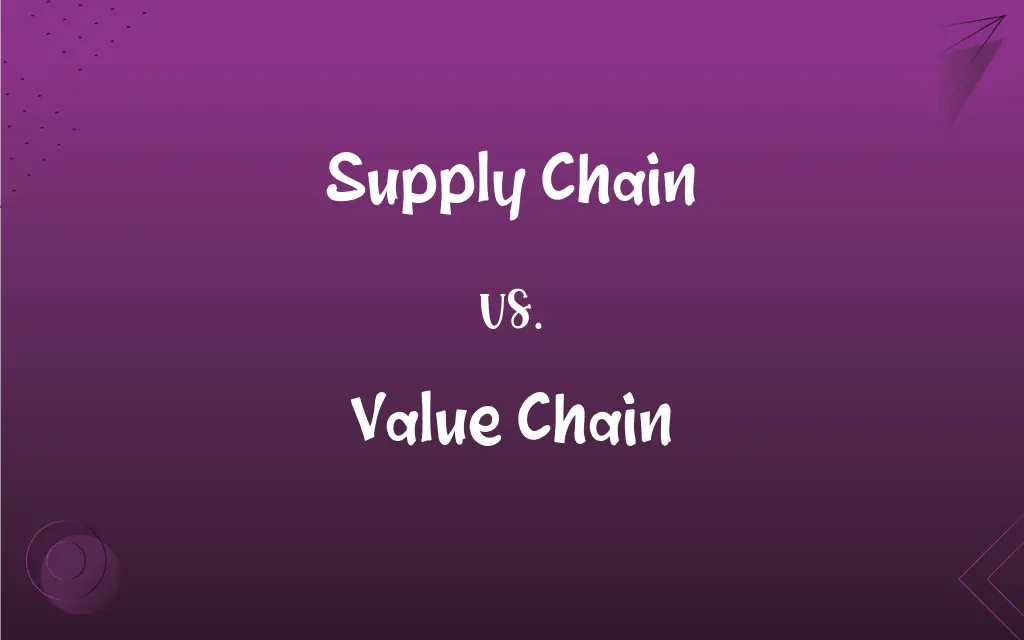Supply Chain vs. Value Chain: What's the Difference?
Edited by Aimie Carlson || By Harlon Moss || Updated on October 20, 2023
The supply chain focuses on the flow of products from raw materials to end-users, while the value chain emphasizes the activities adding value at each stage of production.

Key Differences
The supply chain is an interconnected network of entities and processes responsible for producing, processing, distributing, and delivering products or services to consumers. It's the pathway that goods take from their initial raw materials to the hands of the end-users. Contrarily, the value chain is more focused on the internal operations of an organization, identifying all activities that add value to its products or services at every single stage.
Value chain was introduced by Michael Porter in the 1980s and pertains to the sequential activities an organization undertakes to deliver valuable products or services to the market. It examines how different functions, like marketing, technology development, or operations, bring incremental value to a company's offerings. Meanwhile, the supply chain is more externally oriented, concentrating on how goods move between multiple stakeholders, including suppliers, manufacturers, distributors, retailers, and customers.
While the supply chain aims to ensure the smooth, cost-effective flow of products or services from origin to end-user, the value chain seeks to maximize value creation at each step, leading to competitive advantage and higher profitability. This means the supply chain is more about logistical efficiency and effectiveness, while the value chain zeros in on value proposition enhancement.
In essence, the supply chain and value chain are both crucial concepts in the business world, but they look at organizational processes from different angles. The supply chain emphasizes flow and efficiency in getting a product to the customer, while the value chain focuses on the internal actions that enhance a product's value at every phase.
Comparison Chart
Primary Focus
Flow of products from raw materials to consumers.
Activities adding value at each production stage.
ADVERTISEMENT
Orientation
Externally oriented (multiple stakeholders).
Internally oriented (within the organization).
Key Goal
Ensure smooth, cost-effective product flow.
Maximize value creation at each step.
Representation
Network of entities and processes.
Sequential activities in an organization.
Outcome Objective
Efficient and effective product/service delivery to end-users.
Competitive advantage and increased profitability.
Supply Chain and Value Chain Definitions
Supply Chain
The supply chain is a system of organizations, people, and activities involved in moving a product from supplier to customer.
Efficient supply chain management can significantly reduce costs and improve product delivery times.
ADVERTISEMENT
Value Chain
The value chain represents the steps an organization takes to enhance its offerings' value proposition.
By understanding its value chain, a company can identify areas for improvement and innovation.
Supply Chain
The supply chain encompasses all stages involved in delivering a product, from raw materials to final consumption.
Disruptions in the supply chain can lead to product shortages in the market.
Value Chain
The value chain is a set of activities that businesses undergo to add value to their products or services.
Apple's value chain includes design, manufacturing, marketing, and distribution, leading to its premium product positioning.
Supply Chain
The supply chain is the network that facilitates the transfer of goods from manufacturers to end-users.
Technological advancements have greatly streamlined and optimized supply chain processes.
Value Chain
The value chain is a model that outlines how businesses receive raw materials and add value through various stages until the final product.
The coffee industry has a diverse value chain, from farmers to baristas, each adding a unique value.
Supply Chain
The supply chain represents the interconnected steps through which goods are produced, processed, and distributed.
Global companies often have complex supply chains spanning multiple countries.
Value Chain
The value chain focuses on internal processes that enhance product value at every phase.
Analyzing the value chain can reveal inefficiencies and opportunities for competitive advantage.
Supply Chain
The supply chain is the path a product takes from initial creation to being in the hands of the consumer.
Transparency in the supply chain ensures ethical and sustainable production practices.
Value Chain
The value chain identifies and optimizes the discrete activities contributing to a product's market value.
Companies that effectively manage their value chain can deliver higher quality products at competitive prices.
FAQs
How do supply chain disruptions impact businesses?
Supply chain disruptions can lead to delays, increased costs, product shortages, and loss of business reputation.
What is the primary goal of the supply chain?
The main goal of the supply chain is to ensure a smooth, cost-effective flow of products from producers to consumers.
Is the supply chain only concerned with physical products?
No, supply chains can also pertain to services, detailing the processes from service conception to delivery to the end-user.
Which concept is more internally focused within an organization?
The value chain is more internally focused, examining how organizational functions add value to products or services.
Can the value chain analysis lead to cost reductions?
Yes, by identifying inefficiencies and optimizing value-adding activities, value chain analysis can result in cost savings.
What entities are typically involved in the supply chain?
The supply chain involves suppliers, manufacturers, distributors, retailers, and consumers, among others.
Why is understanding the value chain crucial for businesses?
Analyzing the value chain helps businesses identify areas of improvement, innovate, and create superior value for customers.
How does the value chain relate to company profitability?
By optimizing value-adding activities, the value chain can lead to higher quality offerings, better market positioning, and enhanced profitability.
Are logistics and supply chain the same?
No, logistics is a component of the supply chain, focusing specifically on the movement and storage of goods.
How do global events affect the supply chain?
Global events, like pandemics or geopolitical tensions, can disrupt the supply chain, impacting production, distribution, and costs.
Can startups benefit from value chain analysis?
Yes, startups can use value chain analysis to optimize their operations, maximize value, and achieve competitive positioning.
How does the value chain contribute to competitive advantage?
The value chain focuses on maximizing value at every production phase, leading to superior products and services that can differentiate a company in the market.
How does the value chain enhance a product's market offering?
The value chain focuses on activities that add value at each production stage, leading to competitive advantage and higher profitability.
How do technological advancements impact the supply chain?
Technology can streamline, automate, and optimize supply chain processes, improving efficiency, transparency, and adaptability.
Who introduced the concept of the value chain?
Michael Porter introduced the concept of the value chain in the 1980s.
How does sustainability relate to the supply chain?
A sustainable supply chain focuses on ethical, environmental, and social practices at every stage, ensuring long-term viability and positive brand image.
What's a key challenge in modern supply chain management?
One challenge is ensuring flexibility and adaptability in the face of global disruptions and rapidly changing consumer demands.
Can the value chain be applied to service industries?
Absolutely, the value chain can be adapted to analyze how value is added at each stage of service conception, development, and delivery.
How do businesses benefit from effective supply chain management?
Effective supply chain management can lead to cost savings, faster deliveries, and enhanced customer satisfaction.
What's a primary objective of the value chain?
A key objective of the value chain is to maximize value creation at each activity, enhancing profitability and market position.
About Author
Written by
Harlon MossHarlon is a seasoned quality moderator and accomplished content writer for Difference Wiki. An alumnus of the prestigious University of California, he earned his degree in Computer Science. Leveraging his academic background, Harlon brings a meticulous and informed perspective to his work, ensuring content accuracy and excellence.
Edited by
Aimie CarlsonAimie Carlson, holding a master's degree in English literature, is a fervent English language enthusiast. She lends her writing talents to Difference Wiki, a prominent website that specializes in comparisons, offering readers insightful analyses that both captivate and inform.































































